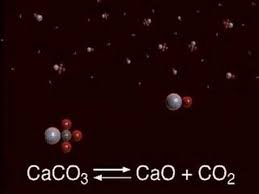Overview:
Chemical equilibrium refers to the state in which opposite processes balance each other so that one does not occur more than the other. Many chemical processes exist which are reversible. Equilibrium does not mean that reactions come to a stop, but that they balance dynamically.
Reversible Reactions
Reversible reactions are chemical processes that oppose one another. The molecule NO2 is a brown gas called nitrogen dioxide, a major component of smog that is in automobile exhaust. It is converted into another component of smog, a colorless gas called dinitrogen tetroxide (N2O4). The colorless dinitrogen tetroxide is converted back to nitrogen dioxide in an opposing reaction. If a sample of nitrogen dioxide is sealed, so that the reaction can continue, the brown color of the original sample will fade as the concentration of nitrogen dioxide is lowered, but it will not fade completely.
|
Figure 1: The double half-arrow going in both directions in a symbol of a reversible reaction. |
Dynamic Equilibrium
Imagine that 20 passengers leave the main bus terminal. At the first stop, two get off the bus, but two more riders come aboard. At the next stop, one rider leaves the bus, and another rider gets on the bus at the following stop. At the fourth stop, three riders get on the bus, but another three leave. There are still 20 passengers on the bus, because the same number have come aboard as have left. There is a lot of activity, even though the overall number of passengers is unchanged. This is similar to the process of dynamic equilibrium, as there is a great deal of activity at the molecular level, yet the substances themselves are not static.
|
Figure 2: The surfboarder constantly changes position to balance while riding the wave. This is an example of dynamic equilibrium. |
Le Chatelier’s Principle
Even though a chemical reaction is at equilibrium, it can be shifted away from equilibrium by changing conditions. Le Chatelier’s principle states that if a system is at equilibrium and something happens to disturb the equilibrium, the system will tend to correct in the direction to compensate for the change in conditions. Imagine a tightrope walker using a pole as a balance tool. The pole can be tilted one way or another to compensate for movement to the left or to the right.
Changes in Concentration, Temperature and Pressure
Some of the changes in a system that can disturb equilibrium are changes in concentration, temperature, and pressure. Suppose that the concentration of nitrogen dioxide is increased in the smog solution. That will make more nitrogen dioxide available to change, so that the reaction will consume more of it, to bring the system back to equilibrium. Similarly, changes in pressure or temperature will shift the system towards one direction or another.
Interested in chemistry tutoring services? Learn more about how we are assisting thousands of students each academic year.
SchoolTutoring Academy is the premier educational services company for K-12 and college students. We offer tutoring programs for students in K-12, AP classes, and college. To learn more about how we help parents and students in Enid, OK: visit Tutoring in Enid, OK



